The following configuration can be defined on the Reconfigure page.
Segment: Represents a network segment located on the L-Platform
Virtual server: Represents a server on the L-Platform
Physical server: Represents a physical server.
Disk: Represents an extended disk that is not a system disk but can be added to the virtual server or physical server.
An example of the Reconfigure page display is shown below.
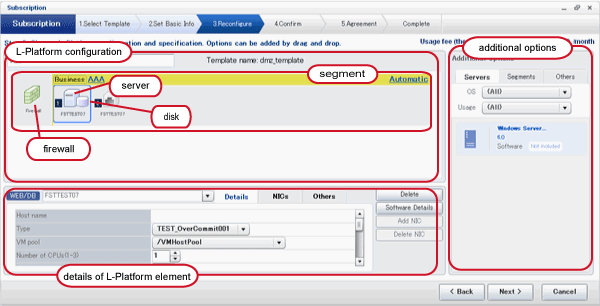
The configuration of the Reconfigure page is shown below:
Part | Description |
|---|---|
L-Platform configuration | Located on the top of the page, this area expresses the L-Platform in terms of the elements of firewall, segment, virtual server, physical server and disk. |
Add options | Located on the right hand side of the page, this area lists the elements of, the virtual server, physical server, segment and disk that can be added to the L-Platform |
Details of L-Platform element | Located at the bottom of the page, this area allows the details of a selected L-Platform element to be edited Click the Delete NIC button to delete selected NICs. |
Icons displayed in the L-Platform configuration area are as follows.
Icon | Explanation |
|---|---|
| Virtual server without data disks |
| Virtual server with one data disk |
| Virtual server with multiple data disks |
| Physical server without data disks |
| Physical server with one data disk |
| Physical server with multiple data disks |
| NIC of a Virtual server |
| NIC of a Physical server |
| Grouped NICs |
| Firewall |
Icons displayed in the L-Platform configuration area to indicate server statuses are as follows.
These are example icons for a virtual server without disks. There are corresponding icons also for a physical server and for a server with no data disk, one data disk, and multiple data disks.
Icon | Explanation |
|---|---|
| Stopped |
| Running |
| Starting, stopping, being deployed, or in a failover |
| Failed to start or stop |
Icons displayed in the Add options area are as follows.
Icon | Explanation |
|---|---|
| Virtual image information without data disks |
| Physical image information without data disks |
| Virtual image information with data disks |
| Management segment |
| Business segment |
| Data disk |
Edit the L-Platform
The L-Platform can be edited on the Reconfigure page.
The L-Platform name entered on the Basic info page can be modified.
Segments cannot be added or deleted using configuration modification on an L-Platform that has already been deployed.
To add a virtual server or physical server, a virtual server or physical server listed in Servers tab of Additional options can be dragged and dropped into the segments.
To add a disk, a disk listed in Others tab of Additional options can be dragged and dropped into the virtual server or physical server.
The types of disks that can be added are new disks and existing disks. New disks can be added to virtual servers and physical servers. Existing disks are displayed if an Infrastructure Administrator has registered them to a storage pool that can reference already created disk resources, and can be added to physical servers.
Firewall
When the firewall is selected, its rule set can be checked. The firewall cannot be deleted.
Firewall tab
Part | Description |
|---|---|
rule set | Displays the name of the 'rule set' set for the firewall. The rule set name cannot be changed. |
Click Setting button to check the parameter values in the rule set. The values set as the default are the values specified in the L-Platform template.
Note
The firewall for a server added by a new L-Platform subscription or L-Platform reconfiguration is set after the L-Platform is deployed. Refer to "8.3.9 Setup Firewall" for details.
Edit a Segment
A segment can be edited by selecting the segment to be edited.
It is possible to select whether a subnet allocated to the segment can be set automatically or manually in the segment editing. Note, however, that subnets cannot be modified in the L-Platform configuration after the system has been deployed.
If the network to be connected to is specified in the L-Platform template, the specified network remains selected.
The following window displays an example of the Reconfigure page when a segment name is clicked. The following window shows the Reconfigure page used to subscribe to an L-Platform.
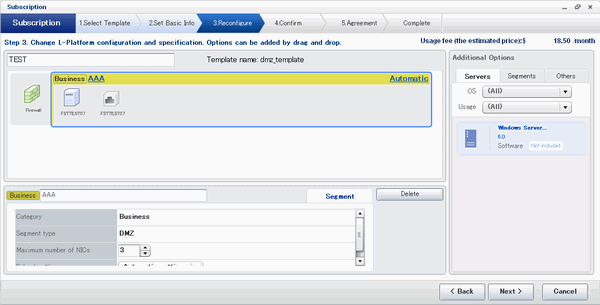
Details of configuration element Segment tab
Part | Description |
|---|---|
Category | Specify the category when an automatically selected segment is added. The default is "Business segment".
|
Segment type | Specify the segment identification information used if segments are selected automatically when additions are made by segment extension. |
Maximum number of NICs | Specify the maximum number of servers that can be deployed in a segment. |
Subnet setting | Specify the IP address of the deployed virtual server used if segments are selected automatically when additions are made by segment extension. The default value is "Automatic setting".
|
Note
If the maximum number of segments in the L-Platform template is one, the IP addresses of virtual servers being deployed can be specified in the subnet settings.
Additional options Segment tab
Part | Description |
|---|---|
Segment |
|
Note
Segment extension and reduction
A network can be extended to the maximum number of segments for an L-Platform Template.
Since at least one segment is required, it is not possible to delete all segments.
When a segment is deleted, the connected NIC is also deleted. Since at least one NIC is also required, it is not possible to delete all NICs.
Extension and reduction are not possible for L-Platforms that have already been deployed.
Edit a Virtual Server
By clicking a virtual server, the virtual server can be edited by selecting the tabs displayed.
Details tab
An example of the Details tab display is shown below.
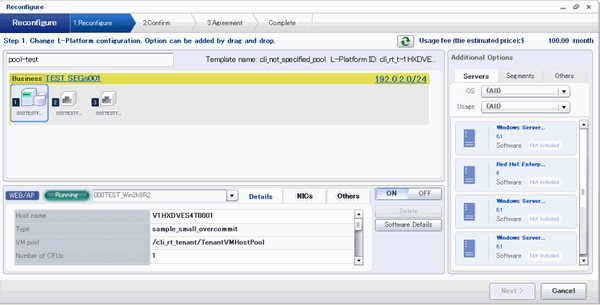
Part | Description | |
|---|---|---|
Host name | Sets the virtual server name specified in the L-Platform template. "usage + (no. of servers + 1)" is set automatically for the virtual server that has been added as an option. <, >, &, ', " and control characters However, the strings and the number of characters that can be specified may vary depending on the system settings. It is recommended that the name be specified using no more than 15 of the following characters. The value specified for this item cannot consist of only numbers. Hyphens cannot be used for the first character. Alphanumeric characters, underscores ("_") and hyphens ("-")A pre-existing name cannot be specified. | |
Type | From the drop-down menu, select the type (specifications) of the registered server. The settings for the following L-Server features are also made:
However, a message may appear indicating that the server type cannot be changed with some types of virtualization software. | |
VM pool | From the drop-down menu, select the resource name of the VM pool that is the server deployment destination. Contact the infrastructure administrator in the event that an error message is displayed indicating that no existing pool can be selected as the server deployment destination. | |
CPU | Number of CPUs | Set the number of CPUs of the virtual server. Specify the lesser of the two values: Enter either the maximum value entered for image information or enter the maximum value of the VM pool, number of cores of VM hosts with the most numbers of cores. A value outside the range cannot be set. |
Performance | Specify CPU performance of the virtual server in GHz. Specify the lesser of the two values: Enter either the maximum value entered for image information or enter the maximum value of the VM pool, value of operational frequency of VM hosts with the most value of operational frequency. A value outside the range cannot be set. | |
Reserved | Specify the reserved CPU performance for the virtual server, in GHz. | |
[VMware] | Specify the relative allotment ratio for determining the allotment of memory size when multiple virtual machines are competing for memory resources. Specify an integer up to 1,000,000. If the reconfiguration simplification function is disabled and the easy selection method is set, set values are as follows:
This is not displayed and cannot be specified if the virtualization software is RHEL-KVM. | |
Memory | Size | Specify the memory size of the virtual server in GB. Specify the lesser of the two values: Enter either the maximum value entered for image information or enter the maximum value of the VM pool, free memory size of VM hosts with the most free memory size. A value outside the range cannot be set. |
[VMware] | Specify the reserved memory size for the virtual server, in GB. | |
[VMware] | Specify the relative allotment ratio for determining the allotment of memory size when multiple virtual machines are competing for memory resources. Specify an integer up to 1,000,000. If the reconfiguration simplification function is disabled and the easy selection method is set, set values are as follows:
This is not displayed and cannot be specified if the virtualization software is RHEL-KVM. | |
System Disk | Storage pool | From the drop-down menu, select the storage pool to be used. |
Size | The disk capacity of the virtual server is displayed in GB. The capacity of the system disk cannot be modified. | |
Boot priority | Sets the priority order when performing batched power supply operations in either the L-Platform or the tenant. The smaller the value, the higher the priority order. Set to 0 when power supply operations are not carried out in a single batch. Note however that this value cannot be set to 0 at the time of new deployment. | |
Point
The icons displayed in front of the virtual server names correspond to the usage of the virtual servers described in the specification.
WEB: Web server
AP: Application server
DB: Database server
When a virtual server has multiple usages, an icon showing each usage separated by "/" will be displayed.
Example: WEB/AP, AP/WEB/DB etc.
Note
The server type cannot be changed with some types of virtualization software.
When the value 0 or no valid value is specified for CPU frequency, CPU reserve clock rate, memory size, or memory reserve size, it is treated as if the value 0.1 were specified. This modification is included in the changed items.
NICs tab
An IP address to be allocated to NIC can be set using the NICs tab.
An IP address can be set only when "manual setting" was specified when the segment was edited for a subnet. Note, however, that a subnet cannot be modified when modifying the configuration of a system that has been deployed, and so the IP address cannot be modified either.
The following example displays the NICs tab. The following window shows the Reconfigure page used to subscribe to an L-Platform.
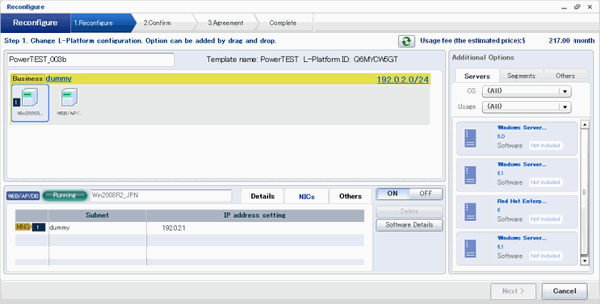
There are two ways of specifying an IP address as follows:
Automatic
Sets an IP address automatically from a subnet.
Manual
Enters an IP address directly.
When there is a conflict between the specified IP address and network resources, an error message will be displayed.
An MNG icon is displayed for the control NIC.
The following window displays an example of an L-Platform where multiple NICs exist. The following window shows the Reconfigure page used to subscribe to an L-Platform.
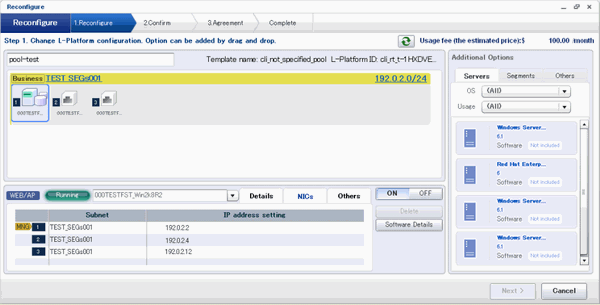
Each NIC is represented by one server. When a server is selected, the same server in each segment is selected.
When a server is selected an icon is displayed showing a number at its lower left hand corner. The number represents an NIC number.
Dark-colored servers are the NICs for administration, and light-colored servers are NICs for business.
When a server is dragged from the Add options and dropped on a segment, as many servers as the number of NICs specified for the segment in the image information are displayed.
NIC Extension and Reduction
This section explains NIC extension and reduction.
Click the Add NIC button to add a business NIC to the same segment as the control NIC.
Click the Delete NIC button deletes an NIC.
Note
This is possible only during L-Platform subscription. NIC extension and reduction are not possible after deployment.
NICs cannot be added if they would exceed the maximum number of connections for the segment.
Control NICs cannot be deleted.
Since at least one NIC is required, it is not possible to delete all NICs.
When extending or reducing NICs for a physical server, configure the number of NICs after settings are made to match the number of NICs of the physical server being used.
Others tab
The Others tab can be used to check the operating system installed at a virtual server, the middleware and other software, and information on the patches applied to the software.
Editing a Physical Server
When a physical server is selected, the allowed physical server depends on the displayed tab.
For a deployed physical server, only the server name, the server type, and the boot priority can be changed.
Details tab
A display example of the Details tab is shown below.
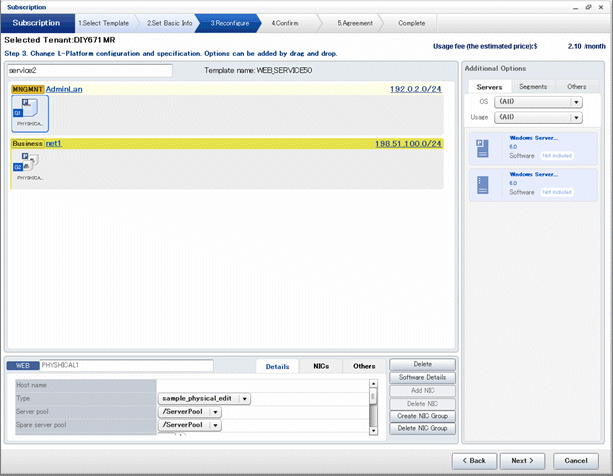
Part | Description | |
|---|---|---|
Host name | Sets the name of a physical server that is in the L-Platform Template. <, >, &, ', " and control characters However, the strings and the number of characters that can be specified may vary depending on the system settings. It is recommended that the name be specified using no more than 15 of the following characters. The value specified for this item cannot consist of only numbers. Hyphens cannot be used for the first character. Alphanumeric characters, underscores ("_") and hyphens ("-")A pre-existing name cannot be specified. | |
Type | From the drop-down menu, select the type (specifications) of the registered server. The settings for the following L-Server features are also made:
| |
Server pool | From the drop-down menu, select the resource name of the server pool that is the server deployment destination. Contact the infrastructure administrator in the event that an error message is displayed indicating that no existing pool can be selected as the server deployment destination. | |
Reserve server pool | From the drop-down menu, select the resource name of the reserve server pool. Contact the infrastructure administrator in the event that an error message is displayed indicating that no existing pool can be selected as the server deployment destination. | |
CPU | Number of CPUs | Set the number of CPUs in the physical server. |
performance | Specify the CPU performance of the physical server in GHz units. If the upper limit value recorded in the image information differs from the VM pool upper limit value (the frequency of the VM host with the highest frequency), a value up to the smaller value can be set. | |
Memory | Size | Specify the memory size of the physical server in GB units. |
System Disk | Storage pool | From the drop-down menu, select the storage pool to be used. |
Size | The disk capacity of the physical server is displayed in GB. The capacity of the system disk cannot be modified. | |
Boot priority | Sets the priority order when performing batched power supply operations in either the L-Platform or the tenant. Range:1-256.The smaller the value, the higher the priority order. Set to 0 when power supply operations are not carried out in a single batch. Note however that this value cannot be set to 0 at the time of new deployment. | |
Note
The server pool physical server with details closest to the specified CPU and memory information is allocated.
Usage fees are calculated according to the values entered for the CPU performance and memory capacity when newly deploying a physical server. The performance of the actual server deployed will be the closest possible to the entered values. For this reason, the usage fees displayed may differ to actual charges.
Usage fees for physical servers that have already been deployed will be calculated according to the actual CPU performance and memory capacity.
NICs tab
Use the NICs tab to set the IP address allocated to an NIC.
Note that the IP address can be set only if "manual setting" is specified for the subnet during segment editing. However, since the subnet cannot be changed by reconfiguration after a system is deployed, IP address changes are also not possible.
A display example of the NICs tab is shown below. Note that the window shown below is the L-Platform subscription Reconfigure page.
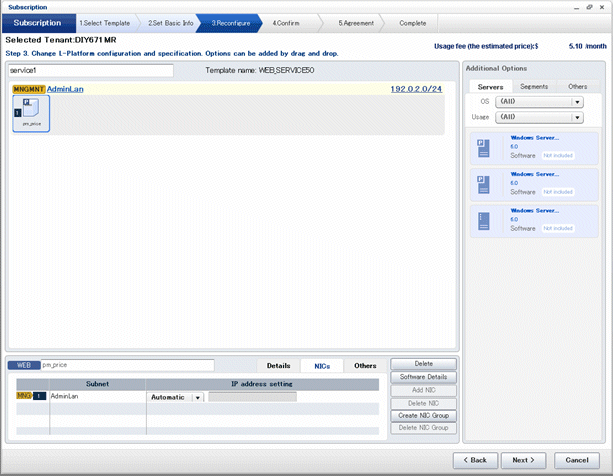
The following two methods are available for specifying an IP address:
Automatic
The IP address is set automatically from the subnet.
Manual
Enter the IP address directly.
An error message is displayed if the specified IP address is inconsistent with the network resources.
The MNG icon is displayed for the control NIC.
The window below is an example of the display when there are multiple NICs. Note that the window shown below is the L-Platform subscription Reconfigure page.
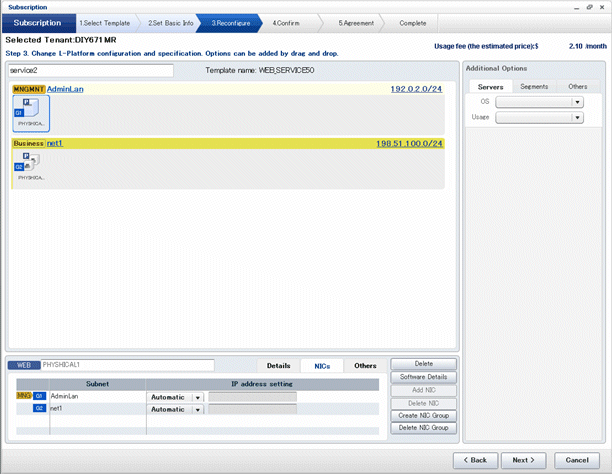
NIC1 is represented by one physical server. When a server is selected, the selected state occurs for all the same servers. A numeric icon is displayed to the bottom left of selected servers. It indicates the NIC number.
Dark-colored servers indicate management NICs, and light-colored servers indicate business NICs.
If a segment is dragged and dropped from the addition option, the number of servers displayed matches the number of NICs specified in the image information of the segment.
NIC Grouping
This function is available with physical servers only.
This section explains NIC grouping.
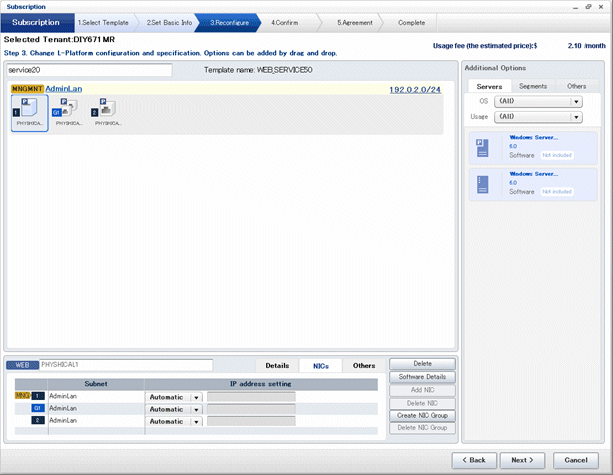
Making a group
Select multiple checkboxes, and then click the Form NIC Group button. However, Multidata input NIC cannot be grouped. Groups can include control NIC.
Cancelling a grouping
Select multiple checkboxes, and then click the Delete NIC Group button.
Note
This is possible only during L-Platform subscription. NIC groups cannot be made or cancelled after deployment.
Two NICs can be grouped. Three or more NICs cannot be grouped.
Others tab
The Others tab can be used to check the operating system installed at a physical server, the middleware and other software, and information on the patches applied to the software.
Edit a Disk (for a Virtual Server)
A virtual server to which a disk has been added can be selected. By clicking the button (![]() ) located to the right of the virtual server name, a selection list of virtual servers and disks is displayed. Select a disk on the list.
) located to the right of the virtual server name, a selection list of virtual servers and disks is displayed. Select a disk on the list.
Only extended disks can be modified when editing a disk. System disks cannot be edited.
The following example displays the Reconfigure page when a disk is selected. The following window shows the Reconfigure page used to subscribe to an L-Platform.
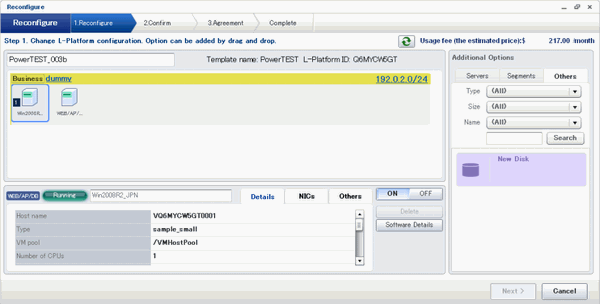
Part | Description |
|---|---|
Disk name | "disk + serial number" is set automatically as the disk name. To rename a disk, the new name must be no more than 85 characters long and not include the following characters: <, >, &, ', " and control characters A pre-existing name cannot be specified. |
Storage pool | From the drop-down menu, select the deployment destination resource pool. |
Size | Specify the disk capacity of the virtual server in GB. Specify the lesser of the two values: Enter either the maximum value entered for image information or enter the maximum value of the storage pool, free space size of storages with the most free space size. |
Note
If the virtualization software is Hyper-V, the maximum number of disks after addition is four, including the system disk.
Only existing disks can be added or deleted if the virtualization software is RHEL-KVM. New disks cannot be added.
Disks cannot be added to or deleted from images that include data disks.
Edit a disk (for a physical server)
Note
Disks can be added to servers that have already been deployed only by stopping the server first.
A physical server to which a disk has been added can be selected. By clicking the button (![]() ) located to the right of the physical server name, a selection list of physical server and disks is displayed. Select a disk on the list.
) located to the right of the physical server name, a selection list of physical server and disks is displayed. Select a disk on the list.
Only extended disks can be modified when editing a disk. System disks cannot be edited.
The following example displays the Reconfigure page when a disk is selected. The following window shows the Reconfigure page used to subscribe to a service.
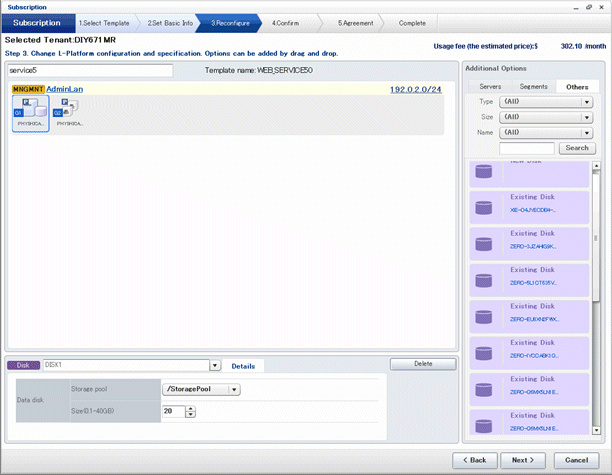
Part | Description |
|---|---|
Disk name | "disk + serial number" is set automatically as the disk name. To rename a disk, the new name must be no more than 85 characters long and not include the following characters: <, >, &, ', " and control characters A pre-existing name cannot be specified. |
Storage pool | From the drop-down menu, select the deployment destination resource pool.If an existing disk is selected, modification is not possible. |
Size | Specify the disk capacity of the virtual server in GB. Specify the lesser of the two values: Enter either the maximum value entered for image information or enter the maximum value of the storage pool, free space size of storages with the most free space size. |
Server tab
"Physical server" and "Virtual server" can be selected from Type, enabling only servers of the selected type to be displayed.